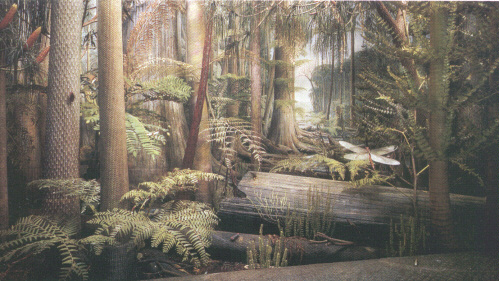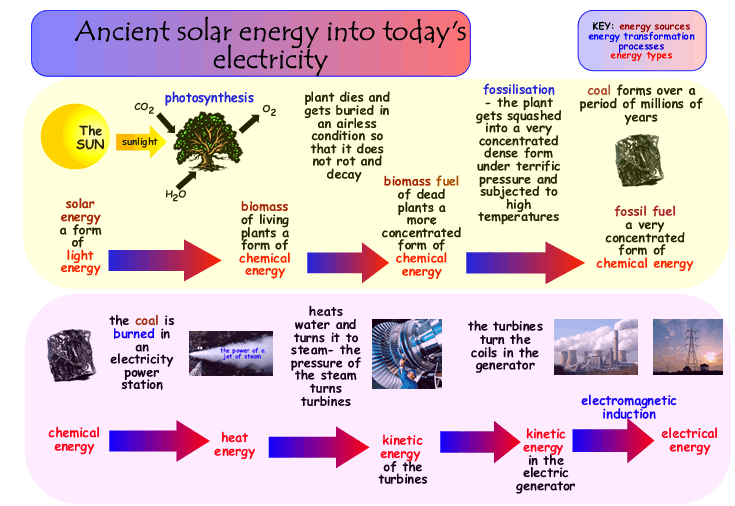Fossil Fuels
Over time the ancient plants and animals died and decomposed, while being squashed under the pressure from tons of rock and ancient seas that were above them (About a 1m depth of prehistoric plant debris was needed to make a depth of 10 cm of coal). Over the vast time expanse, many of the seas receded and left dry land. The dead plants and animals had slowly decomposed into organic materials and formed fossil fuels beneath the surface. Biomass changed into fossil fuel. The diagram below shows how coal was formed. Click here for a Jigsaw of the above graphic. Different types of fossil fuels were formed depending on:
Oil and natural gas were created from aquatic organisms that were buried under ocean or river sediments. Heat, pressure and bacteria combined to compress and "cook" the organic material under layers of silt. In most areas, a thick liquid called oil formed first, but in deeper, hot regions underground, the cooking process continued until natural gas was formed. Over time, some of this oil and natural gas began working its way upward through the earth's crust until they ran into rock formations called "caprocks" that are dense enough to prevent them from seeping to the surface. It is from under these caprocks that most oil and natural gas is produced today. Coal formed from the dead remains of trees, ferns and other plants that lived 300 to 400 million years ago. In some areascoal was formed from swamps covered by sea water. The sea water contained a large amount of sulphur, and as the seas dried up, the sulphur was left behind in the coal. See acid rain. Some coal deposits, however, were formed from freshwater swamps and have very little sulphur in them The cycle needed to form fossil fuels has a very long time period - a tree dying today will not be good quality fossil fuel for a very long time! (See biomass) Therefore the fossil fuels are a limited resource and we should consider carefully as to how we use them. Fossil fuels can be used to make petrochemicals and plastics - medicines and materials - but mostly we use them as a fuel - burn them and create environmental problems by contributuing to acid rain and global warming. Powerful companies that use them to run power stations are trying to sort out some of the environmental problems by cleaning up their industry but the real question here is an ethical one - should we simply burn a resource that we cannot replace that has so many other applications? Is it fair to the generations that follow us? |
Follow me...
|


 Fossil
fuels were formed from plants and animals that lived 300 million years
ago in primordial swamps and oceans.The age they were formed is called
the Carboniferous Period. It was part of the Paleozoic Era. "Carboniferous"
gets its name from carbon, the basic element in coal and other fossil
fuels. Some deposits of coal can be found that formed during the time
of the dinosaurs. For example, thin carbon layers can be found originating
from the late Cretaceous Period (65 million years ago) - the time of Tyrannosaurus
Rex - but the main deposits of fossil fuels are from the Carboniferous
Period. To find out more about the various geologic eras click on the
link .
Fossil
fuels were formed from plants and animals that lived 300 million years
ago in primordial swamps and oceans.The age they were formed is called
the Carboniferous Period. It was part of the Paleozoic Era. "Carboniferous"
gets its name from carbon, the basic element in coal and other fossil
fuels. Some deposits of coal can be found that formed during the time
of the dinosaurs. For example, thin carbon layers can be found originating
from the late Cretaceous Period (65 million years ago) - the time of Tyrannosaurus
Rex - but the main deposits of fossil fuels are from the Carboniferous
Period. To find out more about the various geologic eras click on the
link .



